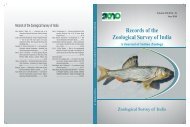Vol. 111 - Part I - Zoological Survey of India
Vol. 111 - Part I - Zoological Survey of India
Vol. 111 - Part I - Zoological Survey of India
You also want an ePaper? Increase the reach of your titles
YUMPU automatically turns print PDFs into web optimized ePapers that Google loves.
64 Rec. zool. Surv. <strong>India</strong><br />
RESULT<br />
The following equation is used in computing the<br />
statistics :<br />
W= aLn or<br />
Log W = Log a + b Log L<br />
Where W= weight <strong>of</strong> fish, L = Length <strong>of</strong> fish, a =<br />
constant, b or n = An exponential expressing<br />
relationship between length-weight. The values are<br />
determined empirically from data.<br />
Log W = – 4.727 + 2.933Log SL (r = 0.9838)<br />
Log W = – 5.123 + 3.000Log TL (r = 0.9870)<br />
The entire data were pooled into an equation for<br />
standard length and total length in relation to weight<br />
separately. The value <strong>of</strong> exponent ‘b’ is 2.993 and 3.00,<br />
when the standard length and total length respectively<br />
was taken as the parameter as such the fish is growing<br />
isometrically in relation to length and thus followed a<br />
cube law. On plotting the observed weight <strong>of</strong> the<br />
species against the observed standard and total length,<br />
a curvilinear graph (Fig. 1 & 2) has been obtained. The<br />
accuracy <strong>of</strong> the equations arrived at was confirmed by<br />
back calculation <strong>of</strong> the weight and comparison with<br />
the observed weight. It has been found that the<br />
calculated weight is less than that <strong>of</strong> observed weight<br />
after attaining a size <strong>of</strong> 210 mm SL (Table-1). Similar<br />
observation has been noticed while plotting the graph<br />
between average observed weight and length (SL and<br />
TL) (Fig. 1). This is due to gonad development as this<br />
fish get maturity after attaining a size <strong>of</strong> 175 mm and<br />
250mm in male and female respectively in the present<br />
climatic conditions (Personal observation). However,<br />
the logarithmic values <strong>of</strong> observed length and<br />
corresponding weight revealed a straight-line<br />
relationship (Fig. 2). Thus the present findings implied<br />
the applicability <strong>of</strong> the cube law to this species. The<br />
regression coefficient ‘r’ was found as (r = 0.9838) for<br />
standard length while (r = 0.9870) for total length.<br />
The value <strong>of</strong> relative condition factor ‘Kn’ was<br />
calculated for different size groups <strong>of</strong> fishes, which<br />
ranges from 0.87 to 1.10 (Fig. 3). The graph depicts<br />
three highest values (1, 1.2, and 1.1) with little variations.<br />
The highest value <strong>of</strong> ‘Kn’ was found between the<br />
length ranges <strong>of</strong> 200-210 mm <strong>of</strong> fishes, which reflect<br />
that fish is towards maturity. Furhter, the high values<br />
are also recorded in the group <strong>of</strong> lower length range <strong>of</strong><br />
50-60 mm and 70-80 mm i.e. 1.10 and 1.02 respectively.<br />
The sudden decline <strong>of</strong> ‘Kn’ value was noticed at 230-<br />
240 mm group which might be due to first maturity <strong>of</strong><br />
fish.<br />
DISCUSSION<br />
According to Wooton (1990) if the fish retains the<br />
same shape and their specific gravity remains<br />
unchanged it shows isometric and the value <strong>of</strong><br />
exponent ‘b’ will be exactly 3.0. The value less than 3.0<br />
shows that fish becomes lighter and greater than 3.0<br />
indicates heavier for a particular length as it increases<br />
in size. Similarly, the analysis <strong>of</strong> the length-weight data<br />
for Schizothorax richardsonii reveals that the value <strong>of</strong><br />
‘b’ is close to 3 and fish shows the isometric growth.<br />
Further, Madan Mohan (2006) reported the value <strong>of</strong> ‘b’<br />
3.0556954 and 2.9695189 for male and female fishes<br />
respectively for the same fish in the Kumaon hills, which<br />
is almost similar to that <strong>of</strong> present observation.<br />
Though, many fishes do not follow the cube law and<br />
may be due to feeding intensity, spawning stresses<br />
and the prevailing water chemistry. According to Hile<br />
(1936) and Martin (1949) the value <strong>of</strong> exponent ‘n’ i.e.<br />
’b” usually ranges between 2.5 and 4 and remain<br />
constant at 3 for an ideal fish and coincide with present<br />
findings. Further, Tesch (1968) also opined that the<br />
exponent ‘n’ or ‘b’ values <strong>of</strong> 3 which indicates the<br />
specific gravity <strong>of</strong> the tissue remains constant<br />
throughout its life for an ideal fish and due to this<br />
reason, the ‘n’ value is found very close to 3 in many<br />
cases. It is known as cube law. Though the value <strong>of</strong> ‘b’<br />
or ‘n’ varies as per different species but variation with<br />
in the species is under the influence <strong>of</strong> several factors<br />
such as seasonal, physiological condition <strong>of</strong> the fish<br />
at the time <strong>of</strong> collection, sex, gonadal development and<br />
nutritive condition <strong>of</strong> the environment. However, Baloni<br />
and Tilak (1985) recorded fist maturity in this fish for<br />
the female 175mm and male 140mm in the Garhwal hills<br />
though based on present study it is noticed that fish<br />
get first maturity after attaining a size <strong>of</strong> 210mm SL due<br />
to which observed weight is more than that <strong>of</strong> the<br />
calculated weight. Further, the correlation coefficient<br />
“r” in case <strong>of</strong> standard length as well as total length<br />
was above 0.9 and indicating high correlation<br />
coefficient.
















